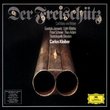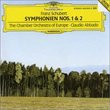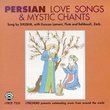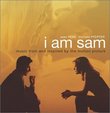| All Artists: Louis Spohr, Johannes Wildner, Slovak State Philharmonic Orchestra, Ernst Ottensamer Title: Spohr: Clarinet Concerti 1 & 3 Members Wishing: 0 Total Copies: 0 Label: Naxos Release Date: 3/21/1995 Genre: Classical Styles: Forms & Genres, Concertos, Historical Periods, Classical (c.1770-1830), Instruments, Reeds & Winds Number of Discs: 1 SwapaCD Credits: 1 UPC: 730099568821 |
Search - Louis Spohr, Johannes Wildner, Slovak State Philharmonic Orchestra :: Spohr: Clarinet Concerti 1 & 3
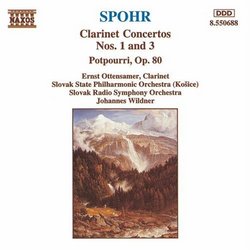 | Louis Spohr, Johannes Wildner, Slovak State Philharmonic Orchestra Spohr: Clarinet Concerti 1 & 3 Genre: Classical
|
Larger Image |
CD DetailsSimilar CDs
Similarly Requested CDs
|
CD ReviewsGreat music, great value! Steve Hager | Ballwin, MO USA | 10/03/2001 (5 out of 5 stars) "This is a nice recording. Very engaging music, well played, well recorded. If you like the clarinet, you'll like this CD. For the price, it's a great buy." Very pleasant G. Metcalf | United States | 10/18/2005 (4 out of 5 stars) "These are well-played versions of these well-crafted works. The playing and recording quality are good. This composer wrote high quality music and these pieces are certainly representative. I would not describe this as an essential CD however. This stuff has a strong similarity to many other contemporaneous music. Probably most recommendable to those with a strong interest in Spohr or clarinet." You don't need to be a clarinetist ... Giordano Bruno | Wherever I am, I am. | 10/10/2009 (4 out of 5 stars) "... to relish the moody beauty of the clarinet's timbre or to appreciate the splendid concertos that co-evolved with the instrument in the late 18th and early 19th Centuries. The key names to 'search' are Stamitz, Krmmer, Mozart, Spohr, and Weber; their works for clarinet - in concertos, quintets, divertimentos, and even operas - are the core of the clarinetist's repertoire.
The clarinet gets its name from the clarino register of the trumpet, but the earlier single-reed 'chalumeau' got its name from the double-reed shawm (Schalmei in German). The proto-chalumeau of the 16th Century -- this is conjecture, mind you -- emerged from somewhere east of Hapsburg Austria. It was an instrument of limited range, about an octave plus one or two notes, very comparable to the capped-reed Krummhorns that were quite popular in Hapsburgia in the era of Isaac and Stoltzer. My guess is that it was played by the same people who played recorders and other winds with finger holes. The Krummhorn could never be 'overblown' to a higher octave as the recorder and cornetto could be, by using a thumb hole or thumb key. In fact, counterintuitively, when you overblow the chalumeau, you jump several notes rather than step up to a second octave. Thus -- again conjecturally -- the chalumeau followed the same path of development as the Krummhorn, toward a lower register by the use of right-hand keys. That would explain why the bassett-horn form of clarinet reached concert-worthiness before the five-key classical-era clarinet. Mozart's sublime clarinet quintet and concerto were both written for bassett instruments. Louis Spohr (1784-1859) was a violinist of considerable reputation but a composer who was widely perceived as 'old-fashioned' in his own time. He was a reluctantly well-traveled sort of musician, bouncing from Russia to Italy to London and finally to Kassel, in what is now Germany, where he stayed for 35 years. The first of his clarinet concertos was composed in 1808, on commission, to be performed by clarinetist Johann Simon Hermstedt. Spohr claimed to have no prior experience with the clarinet, so it's quite likely that he worked closely with Hermstedt. In any case, all of Spohr's subsequent pieces for clarinet were also composed for performance by Hermstedt. Spohr's first effort involved passages that couldn't be well played on any existing clarinet, so Hermstedt either modified or secured modification of his instrument, meaning that Spohr's demands contributed to the evolution of the 'romantic' clarinet for which Weber was later to compose. I have to disagree with previous reviewers about this recording of Spohr's clarinet music. I find the music itself first class but the performance rather lackluster. It's impossible to doubt that Spohr was aware of Mozart's clarinet compositions, and perhaps of Stamitz's also; the echoes are too obvious, especially in the adagio movements. Spohr's frolicking allegros and moonlit adagios, to my ears, do stand up to comparison with Mozart's. The performance recorded here, by the Slovak State Philharmonic, is solidly 'classical' in style and proficient technically, but the clarinetist, Ernst Ottensamer, doesn't excite me much. His fingering and articulations are excellent but his upper register is thin -- flutey, almost mosquito-ish -- enough so that his octaves tend to sound narrow. The CD is still enjoyable listening but I expect that I'll find myself looking for a replacement performance before long." |

 Track Listings (8) - Disc #1
Track Listings (8) - Disc #1
